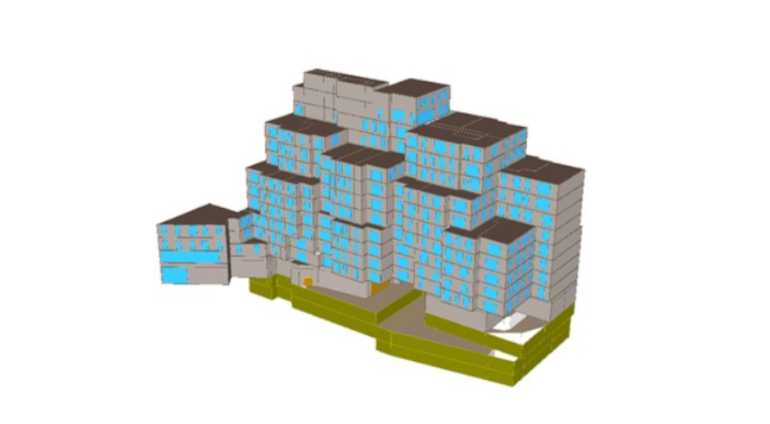Building Energy Modeling

What is Building Energy Modeling?
Building Energy Modeling (BEM) is an advanced computer-based simulation process that analyzes a building's energy consumption patterns and performance. Our certified energy modelers input detailed data to create mathematical models that simulate building performance using thermodynamic principles and building science algorithms.
-
These comprehensive simulations provide valuable insights on:
- Annual energy usage patterns
- Space cooling and heating requirements
- Projected energy costs
- Performance-related metrics
- Carbon emissions impact
BEM serves as an essential tool for evaluating energy-efficiency strategies, optimizing building operations, identifying retrofit opportunities, and conducting both whole-building simulations and component-specific analysis through specialized software.
Benefits of Professional Energy Modeling Services
Energy modeling delivers significant advantages for both new construction and renovation projects by enabling strategic trade-offs between initial investment and long-term energy costs. When integrated early in your design process, our modeling services help:
- Reduce Operating Costs through data-driven energy efficiency improvements
- Enhance Occupant Satisfaction with optimized comfort and environmental quality
- Identify Cost-Effective Solutions for meeting sustainability goals
- Support Compliance Requirements for building codes and certification programs
Working with our energy modeling experts at the beginning of your project helps prevent costly redesigns and ensures your building meets performance targets efficiently.
Energy Modeling Applications
Modern energy modeling is increasingly vital for building efficiency initiatives that enhance performance, support high-performance design, and validate performance claims. Our modeling services address three primary objectives:
- LEED Certification Support Our energy modeling services help you satisfy LEED Building Design + Construction (BD+C) requirements for Energy & Atmosphere Credit 1. We optimize energy performance to determine and document achievable points for your certification goals.
- Energy Code Compliance We demonstrate compliance with commercial building energy codes through performance-based pathway analysis, offering greater design flexibility and often better results than prescriptive approaches.
- NYC Ultra Low Energy Buildings Our energy modeling services can help your project achieve ULEB compliance, earn the 5% FAR bonus, and position your building for long-term sustainability and regulatory compliance.
- C-PACE Energy Assessment We evaluate the impact of individual energy efficiency measures (EEMs) affecting the building design.
- Utility Incentive Programs Our modeling helps qualify your project for valuable utility rebates and incentives available for energy-efficient building designs and systems.
- Section 179D Tax Deduction Under Section 179D of the US tax code, owners of commercial buildings or primary designers can claim substantial tax deductions for properties designed with energy-efficient features. Our energy modeling documentation supports these tax benefit applications.
- Energy Star SEDI We provide comprehensive reports that outline your design metrics, including predicted ENERGY STAR scores for new construction. Our modeling supports Designed to Earn the ENERGY STAR certification applications.
- Measurement & Verification We develop calibrated models that establish baseline conditions for effective Measurement & Verification approaches, helping you quantify actual savings from implemented measures.
Energy Modeling Cost Factors
The scope and complexity of energy modeling services depend on your project's specific needs and goals. Key factors influencing project costs include:
- Additional modeling requirements beyond basic analysis
- Performance targets and certification levels sought
- Project size and complexity
- Building system sophistication
SIMULATION SOFTWARE
Our expert modelers utilize industry-leading whole-building simulation tools selected to match your project requirements. We balance model simplicity and cost-effectiveness while maintaining the accuracy needed to achieve your objectives.
By carefully managing input detail levels and leveraging software capabilities appropriately, we deliver results that maintain accuracy while controlling costs. Our approach focuses on creating models that effectively support decision-making without unnecessary complexity.
Our energy modelers prefer using eQUEST, which is widely accepted in the industry. However, we can use other software tools as needed.
- eQUEST (DOE-2.2, DOE-2.3)
- EnergyPlus (DesignBuilder, OpenStudio)
- IESVE, HAP, TRACE 700, EnergyGuage, Energy Pro
Our Process
-
Project Assessment
- Gather building plans and specifications
- Define performance goals and requirements
- Review applicable codes and standards
- Establish modeling scope and deliverables
-
Model Development
- Create detailed 3D building geometry
- Input building systems and controls
- Define occupancy and usage patterns
- Incorporate weather data and site conditions
-
Analysis & Optimization
- Run baseline and proposed case simulations
- Evaluate system alternatives
- Identify energy conservation measures
- Perform parametric studies
- Calculate energy cost savings
-
Documentation & Reporting
- Generate detailed simulation reports
- Prepare compliance documentation
- Provide energy conservation recommendations
- Develop implementation strategies
- Calculate ROI and payback periods
